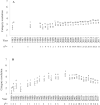Dietary Meat Categories and Descriptions in Chronic Disease Research Are Substantively Different within and between Experimental and Observational Studies: A Systematic Review and Landscape Analysis
- PMID: 31408089
- PMCID: PMC7442319
- DOI: 10.1093/advances/nmz072
Dietary Meat Categories and Descriptions in Chronic Disease Research Are Substantively Different within and between Experimental and Observational Studies: A Systematic Review and Landscape Analysis
Erratum in
-
Corrigendum to O'Connor LE, Gifford CL, Woerner DR, Sharp JL, Belk KE, Campbell WW. Dietary Meat Categories and Descriptions in Chronic Disease Research Are Substantively Different within and between Experimental and Observational Studies: A Systematic Review and Landscape Analysis. Adv Nutr 2020;11(1):41-51.Adv Nutr. 2020 Jan 1;11(1):180. doi: 10.1093/advances/nmz116. Adv Nutr. 2020. PMID: 31945780 Free PMC article. No abstract available.
Abstract
This systematic review and landscape analysis describes patterns in dietary meat (skeletal muscle and associated tissues from mammalian, avian, and aquatic species; i.e., muscle foods) categories (CAT) and descriptions (DESCR) used throughout nutrition-related chronic disease literature, as there is anecdotally noted variation. A total of 1020 CAT and 776 DESCR were identified from 369 articles that assessed muscle food consumption and primary prevention of cardiovascular disease, obesity, type 2 diabetes, or cancer in adults ≥19 y from PubMed, Cochrane, and CINAHL up to March 2018. Specificity of CAT was analyzed on an empirical 1-7 ordinal scale as: 1) broad/undescriptive, "fish"; 2) muscle food type, "red meat"; 3) species, "poultry"; 4) broad + 1 descriptor, "processed meat"; 5) type/species + 1 descriptor, "fresh red meat"; 6) broad/type + 2 descriptors, "poached lean fish"; and 7) specific product, "luncheon meat." Median CAT specificity for randomized controlled trials (RCTs) and observational studies (OBSs) was 3 and 2 points out of 7, respectively, with no differences between chronic disease types. Specificity of OBS CAT was higher in recent articles but RCT CAT became less specific starting in the 2000s. RCT CAT were 400% more likely to include species, 500% more likely to include leanness, but 400% less likely to include processing degree compared with OBS CAT. A DESCR was included for 76% and 82% of OBS and RCT CAT, respectively. Researchers described processed meat, red meat, and total meat CAT more commonly than poultry or fish CAT. Among processed meat DESCR, 31% included a common term used in public regulatory definitions. In conclusion, muscle food categories and descriptions are substantively different within and between experimental and observational studies and do not match regulatory definitions. A practical muscle food classification system is warranted to improve interpretation of evidence regarding muscle food consumption and chronic disease.
Keywords: animal proteins; dietary guidance; dietary intake assessment; fish; flesh foods; food group terminology; muscle foods; poultry; red meat; white meat.
Copyright © American Society for Nutrition 2019.
Figures





References
-
- Seman DL, Boler DD, Carr CC, Dikeman ME, Owens CM, Keeton JT, Pringle TD, Sindelar JJ, Woerner DR, de Mello AS et al. .. Meat science lexicon. Meat and Muscle Biology. 2018;2(1):127–41.
-
- U.S. Department of Health and Human Services and U.S. Department of Agriculture. Scientific Report of the 2015 Dietary Guidelines Advisory Committee. [Internet]. 1st Edition,February2015. Available from: https://health.gov/dietaryguidelines/2015-scientific-report/pdfs/scienti... (accessed 5 December, 2018).
-
- Moher D, Liberati A, Tetzlaff J, Altman DG. Preferred reporting items for systematic reviews and meta-analyses: the PRISMA statement. Int J Surg. 2010;8(5):336–41. - PubMed
-
- U.S. Department of Agriculture, Food Safety Inspection Service. Code of Federal Regulations, Title 9, Part 301, Section 2. Title, 2010. [Internet]. Available from: https://www.gpo.gov/fdsys/granule/CFR-2010-title9-vol2/CFR-2010-title9-v... (accessed 19 December, 2018).
-
- Navarro A, Diaz MP, Munoz SE, Lantieri MJ, Eynard AR. Characterization of meat consumption and risk of colorectal cancer in Cordoba, Argentina. Nutrition. 2003;19(1):7–10. - PubMed
Publication types
MeSH terms
LinkOut - more resources
Full Text Sources
Medical
Miscellaneous

